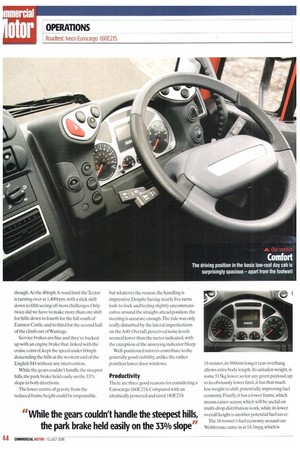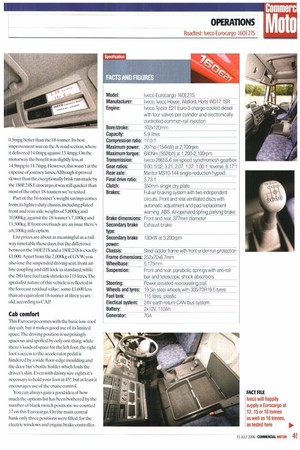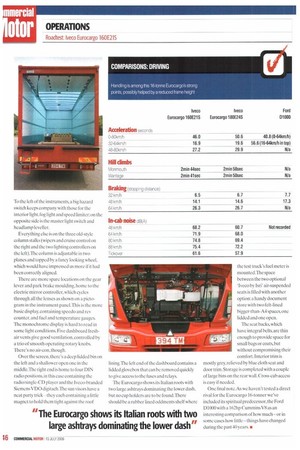NEW KM ON THE BLOCK
Page 43

Page 44

Page 45

Page 46

If you've noticed an error in this article please click here to report it so we can fix it.
\ot all trucks fit neatly into the established pigeonholes. This week's test vehicle, for example, is a 16-tanner for the 21st century...
The 'natural order' of rigid trucks has become well defined over the years, driven by a mixture of tradition, legislation and common sense. In two-axle terms they run from the 7.5-tonne car driver special to the 18-tonne maximum allowed by current legislation. And if you can't make up your mind the 12-tanner sits in the middle, offering a useful compromise.
So, why would anyone upset the natural order by offering a 16-tanner?
This Iveco stands out from the crowd without turning a wheel. It's the first 16-tonner to he tested under the current weight structure (although before 1987 we did test its predecessors such as the Ford D1614). It's also likely to be the last Euro-3 truck to be tested by CM, certainly above 7.5 tonnes. Our test truck is a 160E21S; it has a 16tonne G VW and a power rating of 210PS (207hp/154kVv); the second lowest powered variant in the six-cylinder Tector range. Eight wheelbases are available from 3,105 to 6,570mm, providing space for bodywork up to 10,100mm.This example has the 5.175mm option, carrying a 25ft (7,620mm) box body from Newland Coachworks. although it could manage another foot.
On the road
Another landmark provided by this test is that it's our first truck with a digital tacho.We now have to pay attention to the performance in real time, rather than looking at a visual tachograph trace at the end of the day. But if it had a proper disc, the line would have only shown a drop from limited speed during the frequent roadworks along the M4 section, such is the performance of the truck, Despite its modest (for a two-axle rigid) power-to-weight ratio of 12.9hp/tonne, the performance is good — significantly faster in acceleration and on the hill climbs than the 18tome 240 version we tested last summer.The engine is surprisingly flexible, and it's perfectly feasible to use only the even-numbered gears from standstill on fairly level terrain.
Six gears are plenty for most needs, but there isn't one suitable for a fully laden 25% hill start, at least not without abusing the clutch. If you need this sort of hill climbing ability you'd be well advised to specify the nine-speeder with its much greater spread of ratios.
The six-speed Iveco box has a driverfriendly change: precise and commendably consistent. It saw surprisingly little action, though.At the 40mph A-road limit the Tector is turning over at 1,400rpm, with a slick shift down to fifth seeing off most challenges. Only twice did we have to make more than one shift for hills: down to fourth for the hill south of Eastnor Castle, and to third for the second half of the climb out of Wantage.
Service brakes are fine and they're backed up with an engine brake that, linked with the cruise control, kept the speed under 60rriph descending the hills at the western end of the English M4 without any intervention.
While the gears couldn't handle the steepest hills, the park brake held easily on the 33% slope in both directions.
The lower centre of gravity from the reduced frame height could be responsible, but whatever the reason, the handling is impressive. Despite having nearly five turns lock-to-lock and feeling slightly uncommunicative around the straight-ahead position, the steering is accurate enough.The ride was only really disturbed by the lateral imperfections on the A40. Overall, perceived noise levels seemed lower than the meter indicated, with the exception of the annoying indicator bleep.
Well-positioned mirrors contribute to the generally good visibility, unlike the rather pointless lower door windows.
Productivity
lliere are three good reasons for considering a Eurocargo 160E21S. Compared with an identically powered and sized 180E21S 18-toriner, its 560mm longer rear overhang allows extra body length. its unladen weight, is some 515kg lower, so for any given payload, up to its obviously lower limit, it has that much less weight to shift, potentially improving fuel economy. Finally, it has a lower frame, which means easier access, which will be useful on multi-drop distribution work, while its lower overall height is another potential fuel saver.
The 16-tonner's fuel economy around our Welsh route came in at 14.3mpg.which is 0.5mpg better than the 18-tonner. Its best improvement was on the A-road section, where it delivered 14.0mpg against 114mpg. On the motorway the benefit was slightly less, at 14.9mpg to 14.7mpg. However, this wasn't at the expense of journey times Although it proved slower than the exceptionally brisk run made by the 180E24S Eurocargo, it was still quicker than most of the other 18-tonners we've tested Part of the 16-tonner's weight savings comes from its lighter-duty chassis, including plated front and rear axle weights of 5,800kg and 10,900kg, against the 18-tonner's 7,100kg and 11,500kg. If front overloads are an issue there's a 6,100kg axle option.
List prices are about as meaningful as a railway timetable these days, but the difference between the 160E218 and a 180E21S is exactly £1 ,000. Apart from the 2,000kg of GVW, you also lose the suspended driving seat, front airline coupling and diff-lock as standard, while the 280-litre fuel tank shrinks to 115 litres.The specialist nature of this vehicle is reflected in the forecast residual value: some £1,600 less than an equivalent 18-tonner at three years old, according to CAP
Cab comfort
This Eurocargo comes with the basic low-roof day cab, but it makes good use of its limited spaee.The driving position is surprisingly spacious and spoiled by only one thing: while there's loads of space for the left foot, the right foot's access to the accelerator pedal is hindered by a wide floor-edge moulding and the door bin's bottle holder which fouls the driver's shin. Even with dainty size eights it's necessary to hold your foot at 450, but at least it encourages use of the cruise control.
You can always gain a good idea of how much the options list has been bothered by the number of blank switch positions: we counted 17 on this Eurocargo. On the main central bank only three positions were filled, for the electric windows and engine brake controller. To the left of the instruments, a big hazard switch keeps company with those for the interior light, fog light and speed limiter: on the opposite side is the master light switch and headlamp leveller.
Everything else is on the three old-style column stalks (wipers and cruise control on the right and the two lighting controllers on the left).'The column is adjustable in two planes and topped by a fancy looking wheel, which would have impressed us more if it had been correctly aligned.
There are more spare locations on the gear lever and park brake moulding, home to the electric mirror controller, which cycles through all the lenses as shown on a pictogram in the instrument panel.This is the more basic display, containing speedo and rev counter, and fuel and temperature gauges. The monochrome display is hard to read in some light conditions. Five dashboard freshair vents give good ventilation controlled by a trio of smooth operating rotaly knobs. There's no air-con, though.
Over the screen, there's a deep lidded bin on the left and a shallower open one in the middle.The right end is home to four DIN radio positions, in this case containing the radio/single-CD player and the Iveco-branded Siemens VDO digitach.The sun visors have a neat party trick they each containing a little magnet to hold them tight against the roof lining. The left end of the dashboard contains a lidded glovebox that can he removed quickly to give access to the fuses and relays.
The Eurocargo shows its Italian roots with two large ashtrays dominating the lower dash, but no cup holders are to be found.There should be a rubber lined oddments shelf where the test truck's fuel meter is mounted.The space between the two optional `Iveco by Isri' air-suspended seats is filled with another option: a handy document store with two felt-lined bigger-than-A4 spaces, one lidded and one open.
The seat backs, which have integral belts, are thin enough to provide space for small bags or coats, but without compromising their comfort. Interior trim is mostly grey, relieved by blue cloth seat and door trim. Storage is completed with a couple of large bins on the rear wall. Cross-cab access is easy if needed.
One final note. As we haven't tested a direct rival for the Eurocargo 16-tonner we've included its spiritual predecessor, the Ford D1000 with a 162hp Cummins V8 as an interesting comparison of how much — or in some cases how little— things have changed during the past 40 years. •
































































































































































































